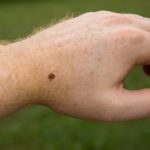May is Lyme Disease Awareness Month, but what exactly is Lyme disease? Well, Lyme disease is a tick-borne illness, one of zoonotic diseases, just like salmonella and E.coli. Lyme disease cases rise in the summer months, so making our readers aware of this threat prior to the season can better help them avoid the disease.
Here we put together a roundup of articles regarding Lyme disease and its symptoms, such as water on the knee. Furthermore, we explain and highlight the key differences between fibromyalgia and Lyme disease, which are often confused.
Advertisement
We hope you learn more, not only about Lyme disease, but about ways to protect yourself during the warmer months.
 Fibromyalgia vs. Lyme disease, differences in symptoms, causes, and treatment options
Fibromyalgia vs. Lyme disease, differences in symptoms, causes, and treatment options
Fibromyalgia and Lyme disease are two illnesses that can cause fatigue and pain, but there are vast differences when it comes to their causes, symptoms, and treatment. Although it may be easy to confuse the two, they are very much different, and these differences can help aid in appropriate treatments.
Lyme disease is known as the “Great Imitator,” because it presents itself as many other illnesses. Furthermore, Lyme disease can affect any part of the body, so a doctor may be confused by the symptoms and try to rule out other conditions first.
Patients with Lyme disease are often misdiagnosed with chronic fatigue syndrome, fibromyalgia, multiple sclerosis, and even mental illnesses like depression. Misdiagnosis of Lyme disease, and fibromyalgia, can be harmful as it can lead to unnecessary medications resulting in side effects and delaying the appropriate mode of treatment. This is why it’s so important to understand the differences between diseases that have common symptoms so that to find the appropriate treatment for each disease and start it early. Continue reading…
 Early sign of Lyme disease could be “water on the knee”
Early sign of Lyme disease could be “water on the knee”
A condition known as “water on the knee” – spontaneous knee effusion – could be a primary sign of early Lyme disease. Early detection and diagnosis is crucial for Lyme disease as it can prevent complications and speed up recovery.
Lyme disease is transmitted through deer-tick bites and is commonly reported in the Northwest or upper Midwest regions of the U.S. Annually, the Centers for Disease Control and Prevention reports 30,000 cases of Lyme disease, but according to their estimate about 300,000 cases go unreported.
Lead study author Elizabeth Matzkin said, “It is important to catch and treat Lyme disease early because the symptoms get progressively worse over time. However, the lab tests used to diagnose Lyme disease can take time to process, and there are certain circumstances in which immediate antibiotic treatment may be recommended before the lab results are complete.” If symptoms have been present for less than two weeks, the Lyme test may need to be repeated as the test can remain negative the first two weeks of an infection.
Matzkin added, “The current standard of care for the diagnosis of Lyme disease is a two-tier blood test. Antibiotic treatments are successful in 99 percent of patients who are diagnosed early and in 90 percent of patients who are diagnosed later. If left untreated, 60 percent of patients eventually develop Lyme arthritis, with the most severe cases having higher risks of permanent joint damage.” Continue reading…
 Preventing zoonotic diseases like Lyme disease, salmonella, E.coli from pets
Preventing zoonotic diseases like Lyme disease, salmonella, E.coli from pets
Zoonotic diseases are those transferred from animals to humans, including Lyme disease, salmonella, and E. coli. Zoonotic diseases are caused by bacteria, viruses, parasites, or fungus. The Centers for Disease Control and Prevention (CDC) reports that six out of 10 infectious diseases found in humans result from animals.
We interact with animals on a daily basis – our pets, livestock, and even wild or zoo animals.
Although many zoonotic diseases can be treated, many of them pose serious health complications and can even be fatal. Some more dangerous zoonotic diseases include Lyme disease, West Nile virus, dengue, malaria, chikungunya, salmonella, and E. coli. Continue reading…
 Lyme disease-causing ticks spread across the U.S.
Lyme disease-causing ticks spread across the U.S.
Lyme disease-causing ticks are spreading within the U.S., a new report states. These ticks can now be found in nearly half of all American counties, which is a much larger range than previously found in the 1990s.
Study author Dr. Rebecca Eisen explained the findings revealed “that the distribution of Lyme disease vectors has changed substantially over the last nearly two decades and highlights areas where risk for human exposure to ticks has changed during that time.”
Lyme disease is transmitted by the black-legged and western black-legged tick (deer tick), and can cause symptoms like fever, headache, and fatigue. Recognizing the ticks’ locations can help doctors properly diagnose the condition as it can often be mistaken for the flu. Continue reading…
 Why Lyme disease is so hard to diagnose
Why Lyme disease is so hard to diagnose
You may have been hearing more and more about Lyme disease as the summer presses on. The Centers for Disease Control and Prevention recently put out a report indicating cases of Lyme disease are on the rise in certain parts of the U.S.
Advertisement
Lyme disease is an illness caused by a bite by a deer tick. Symptoms of Lyme disease include fatigue, headache, muscle spasms, chills, fever, skin rash, and numbness. Lyme disease continues to be difficult to diagnose. But with medical advancements, why is getting to the bottom of this illness so hard?
As of late, many celebrities have opened up about their Lyme disease. Many shared their experiences detailing how afraid they were when they didn’t know what was wrong.
As awareness of Lyme disease and prevention increases, hopefully, cases will begin to subside. In the meantime, let’s examine why it takes a long time for people to be diagnosed. Continue reading…
